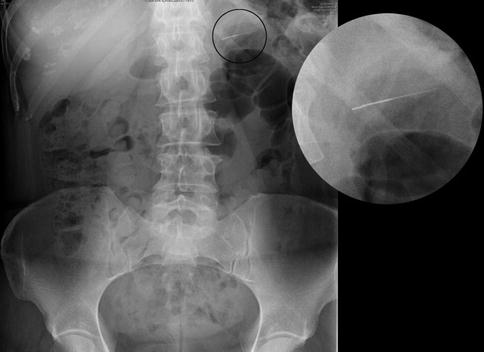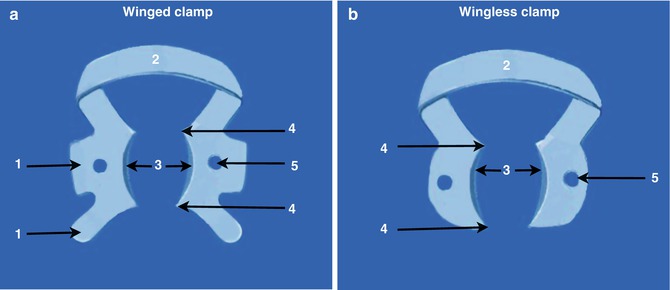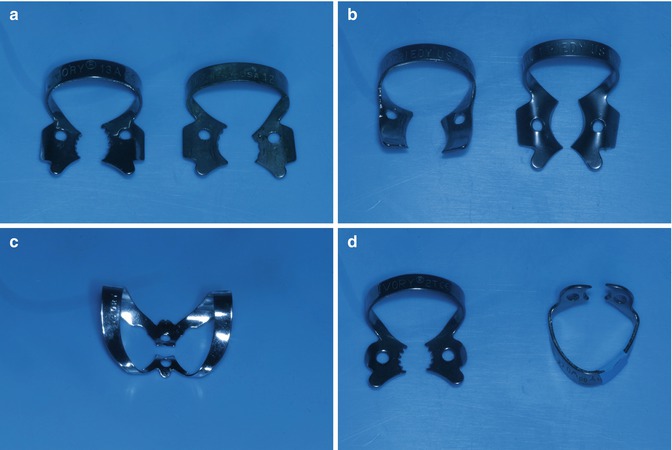(1)
Canberra, ACT, Australia
Summary
Rubber dam is recommended for all nonsurgical endodontic procedures. The literature suggests that rubber dam is not routine practice for many dentists, and many unfounded reasons have been cited.
Clinical Relevance
Rubber dam is essential not only for providing an aseptic technique, which is the premise of root canal treatment, but also from a safety and medicolegal perspective. Failure to use rubber dam has been shown to indirectly affect outcome by choice of irrigant used. Numerous case reports have been described in the literature demonstrating ingestion or inhalation of instruments when dam has not been used. From a medicolegal standpoint when root canal treatment is undertaken and mishap occurs, the case is indefensible when rubber dam has not been used as a preventive measure. If rubber dam cannot be placed or tolerated by the patient, then perhaps other alternative treatments should be provided.
14.1 Overview of Rubber Dam Usage in Endodontics
Root canal treatment procedures should be carried out only when the tooth is isolated by rubber dam to prevent salivary and bacterial contamination, prevent inhalation and ingestion of instruments and prevent irrigating solutions escaping into the oral cavity [1]. Tooth isolation using the dental dam is the standard of care; it is integral and essential for any nonsurgical endodontic treatment [2]. However, not all dentists are accustomed to or routinely use a dental dam when embarking on nonsurgical root canal treatment. Surveys taken in several countries have confirmed, time after time, that rubber dam usage when performing root canal treatment is not the standard of care [3–6].
Many reasons have been cited in the literature as to why this simple technique has not been routinely advocated including cost of equipment and material, difficulty in use, time required for application and lack of patient acceptance [7, 8]. These reasons tend to be unfounded and in fact patients themselves tend to be more appreciative as to treatment under rubber dam providing satisfaction for most [9].
Most dentists are educated in rubber dam use in dental school, but there is often disparity between what is taught for endodontic procedures as an undergraduate and what is practised having graduated. One study even demonstrated that despite the majority of questionnaire respondents having postgraduate training in the last 2 years, only a minority used rubber dam routinely for endodontic treatment [10]. It has been suggested that predoctoral dental educators need to look for opportunities for improvement to reduce the discrepancy between what is taught and the general practice of dentistry [11].
It has been shown without doubt that one of the major benefits of using rubber dam is to provide protection to the patients’ oropharynx by preventing inhalation or ingestion of endodontic instruments or materials during treatment procedures [12–14] (Fig. 14.1). From a medicolegal standpoint, dental defence organisations have reported that any injury inflicted whilst not using a rubber dam during root treatment is deemed ‘indefensible’ [14].


Fig. 14.1
Abdominal radiograph taken in an accident and emergency department after a patient had swallowed an endodontic instrument. The patient had been undergoing root canal treatment without the use of rubber dam resulting in this unacceptable outcome. The patient was referred to the Oral Maxillofacial department and following appropriate investigations the instrument was retrieved using endoscopy by the Gastro-enterology team (Courtesy of Dr Mark Singh Oral & Maxillofacial consultant)
Rubber dam usage during nonsurgical root canal treatment confers several advantages to both clinician and patient (see Table 14.1).
Table 14.1
Advantages of using rubber dam
|
Medicolegal considerations – the prevention of ingestion or inhalation of endodontic instruments or materials
|
|
Enhanced patient safety – prevention of ingestion of harmful endodontic materials such as irrigation solutions. Protection of soft tissues such as lips, cheeks and tongue from trauma
|
|
Aseptic working environment – prevention of salivary contamination of the tooth resulting in microbial contamination of root canal in vital cases and further infections in non-vital cases
|
|
Improved access – rubber dam provides visual contrast which is helpful when working under a dental operating microscope or magnification such as dental loupes
|
|
Improved patient comfort – most patients find the use of rubber dam a comfort since they know that fluids are prevented from accumulating in the mouth and the tongue can move freely without risk of injury
|
|
Reduction of aerosol contamination – results in less cross contamination for both patient and clinician/dental assistant
|
A modified disinfection protocol can be used following assembly of rubber dam using a combination of 30 % hydrogen peroxide, 5 or 10 % iodine tincture, 1–5 % sodium hypochlorite solution and 0.2 % chlorhexidine solution to ensure the field is decontaminated prior to access preparation [15].
It has been recommended that seepage of fluid may be prevented by using a paste such as a mixture of zinc oxide powder and denture adhesive between the tooth and the dam [16]. A commercially available cellulose/zinc oxide material (OraSeal, Ultradent Products, Inc., South Jordan, UT, USA), which forms a firm gel on contact with saliva, is able to patch small leaks conveniently.
There are numerous case reports of patients who develop immediate- or delayed-type allergic reactions following the use of latex rubber dam [17]. The patient must be questioned as to any possible latex allergy in their medical history questionnaire prior to commencement of treatment. In cases where there is suspicion of latex allergy, non-latex rubber dam and gloves are recommended.
14.2 Rubber Dam Armamentarium
Rubber dam
Various rubber dams are available in pre-cut squares of various colours (green, black and purple) and thickness (such as light, medium, heavy and extra heavy). Thin rubber dam (light) is much easier to apply but is more subject to tearing. Conversely thicker dam (heavier) is more difficult to pass through interproximal contacts but more resistant to tearing. The rubber dam should be stored in a cool dry environment to retain its elasticity, preventing the possibility of tearing when stretched.
Rubber dam clamps
The rubber dam clamp helps anchor the rubber dam to the tooth. Numerous rubber dam clamps are available depending on the manufacturer. Essentially clamps can be classified as either winged or wingless, consisting of a set of jaws (serrated or non-serrated) connected to a bow. Clamps come in various sizes and are selected according to tooth selection (anterior, canine/premolar and molar), operator preference and application technique to be employed (clamp first, bow first or anterior tooth). The selected clamp should have a four-point contact on the tooth, avoiding the gingivae if possible, thereby minimising trauma (Figs. 14.2 and 14.3).



Fig. 14.2
Diagrams representing anatomy of a (a) winged and (b) wingless rubber dam clamp. Note (1) clasp arm consisting of lingual and buccal wings, (2) distal bow, (3) jaws, (4) contact points and (5) perforation

Fig. 14.3
Clinical photographs showing various clamps used for (a, b) the posterior teeth, (c) anterior teeth and (d) premolars and canines
Rubber dam napkin
Stay updated, free dental videos. Join our Telegram channel

VIDEdental - Online dental courses


